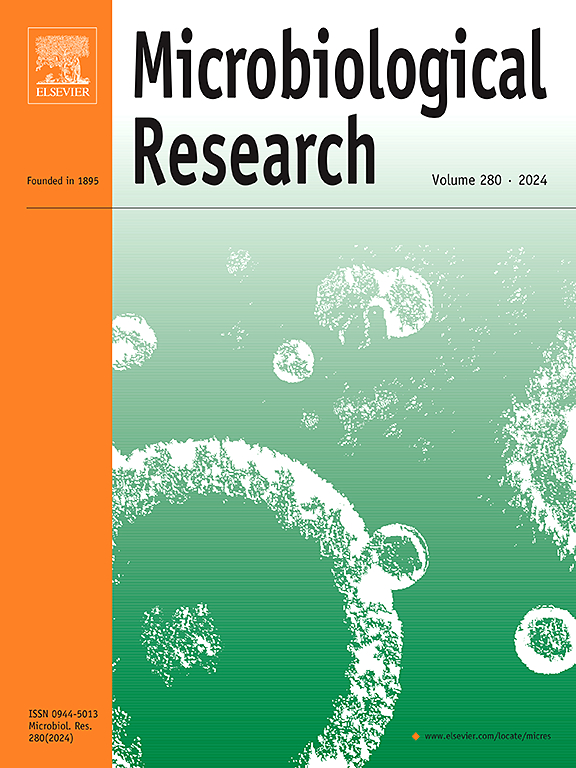Pirin是一种氧化还原敏感的β -氧化调节剂,可产生羟基自由基,并与链霉菌中主要营养过氧化氢酶基因的转录抑制因子CatR相互作用
IF 6.9
1区 生物学
Q1 MICROBIOLOGY
引用次数: 0
摘要
Pirins是在整个进化过程中保守的含铁蛋白,它与多种细胞过程有关,主要与压力有关。在原核生物中,Pirins存在于许多分类类群中,并且可以存在于多个拷贝中,但只有少数这些蛋白质被研究过。在双氧菌链霉菌中,pirin样蛋白PirA是一种氧化还原敏感的AcdB负调剂,AcdB是一种很长链酰基辅酶a脱氢酶(vLCAD),催化β -氧化途径的第一步。在本研究中,我们首先将Pirins在不同的原核和非原核分类群中进行了分类,并发现Pirins的发生与有氧能量代谢之间有很强的联系。在观察到双氧杆菌的一个ppira缺陷突变体在营养生长过程中积累了大量的H2O2后,我们研究了Pirins的存在是否与抗氧化系统的调节有关。体外实验表明,在pirA突变体中H2O2的积累可能部分是由于AcdB的vLCAD活性增加,AcdB释放H2O2作为反应的副产物。然而,尽管细胞内H2O2含量增加,但pirA突变体中过氧化氢酶和烷基氢过氧化物酶表达水平的降低也表明这些抗氧化系统的失调。事实上,编码主要营养过氧化氢酶的基因catA和邻近的调节基因catR在pirA突变体中被下调。在革兰氏阳性细菌中,CatR/PerR家族调节因子抑制主要营养过氧化氢酶编码基因的转录。这些抑制因子被羟基自由基不可逆地失活并与DNA分离,从而导致过氧化氢酶表达的去抑制。我们发现,PirA在与H2O2反应后产生羟基自由基,并在体外与CatR结合,这表明PirA通过对H2O2暴露产生羟基自由基,促进CatR失活,从而使catA转录。本文章由计算机程序翻译,如有差异,请以英文原文为准。
Pirin, a redox-sensitive modulator of beta-oxidation, generates hydroxyl radicals and interacts with CatR, the transcriptional repressor of the major vegetative catalase gene in Streptomyces
Pirins are iron-containing proteins conserved throughout evolution, which have been implicated in diverse cellular processes, mostly associated with stress. In prokaryotes, Pirins are present in many taxonomic groups and can be present in multiple copies, and only a few of these proteins have been studied. In Streptomyces ambofaciens a Pirin-like protein, PirA, is a redox-sensitive negative modulator of AcdB, a very long-chain acyl-CoA dehydrogenase (vLCAD), which catalyzes the first committed step of the beta-oxidation pathway. In this study, we first classified the Pirins in different prokaryotic and non-prokaryotic taxa, and we found strong connections between the occurrence of Pirins and aerobic energy metabolism. We then studied whether the presence of Pirins is connected to the regulation of antioxidant systems, after observing that a pirA-defective mutant of S. ambofaciens accumulated large amounts of H2O2 during the vegetative growth. In vitro experiments suggested that the accumulation of H2O2 in the pirA mutant could be partially due to an increased vLCAD activity of AcdB, which releases H2O2 as a byproduct of the reaction. However, the reduction in catalase and alkylhydroperoxidase expression levels in the pirA mutant, despite the increased amount of intracellular H2O2, also indicated a dysregulation of these antioxidant systems. Indeed, the gene catA encoding the major vegetative catalase and the adjacent regulatory gene catR were down-regulated in the pirA mutant. In Gram-positive bacteria, CatR/PerR family regulators repress transcription of genes coding for the major vegetative catalase. These repressors are irreversible inactivated by hydroxyl radicals and detach from the DNA, which leads to de-repression of catalase expression. We found that PirA generates hydroxyl radicals after reacting with H2O2, and binds CatR in vitro, suggesting that by generating hydroxyl radicals in response to H2O2 exposure, PirA could promote CatR inactivation allowing catA transcription.
求助全文
通过发布文献求助,成功后即可免费获取论文全文。
去求助
来源期刊

Microbiological research
生物-微生物学
CiteScore
10.90
自引率
6.00%
发文量
249
审稿时长
29 days
期刊介绍:
Microbiological Research is devoted to publishing reports on prokaryotic and eukaryotic microorganisms such as yeasts, fungi, bacteria, archaea, and protozoa. Research on interactions between pathogenic microorganisms and their environment or hosts are also covered.
 求助内容:
求助内容: 应助结果提醒方式:
应助结果提醒方式:


